Last Updated on 11/22/2021 by Veronica Jones
Dogs come in all kinds of interesting colors and patterns, but few coats are more striking than spots. Whether the dog has well-defined spots, variably sized ticking, or spots and blotches of different colors known as Merle, you can bet on spotted dog breeds to be eye-catching. From tiny to huge, hairless to fluffy, learn everything that you need to know about 10 of the most beautiful and interesting spotted dog breeds.
1. Dalmatian
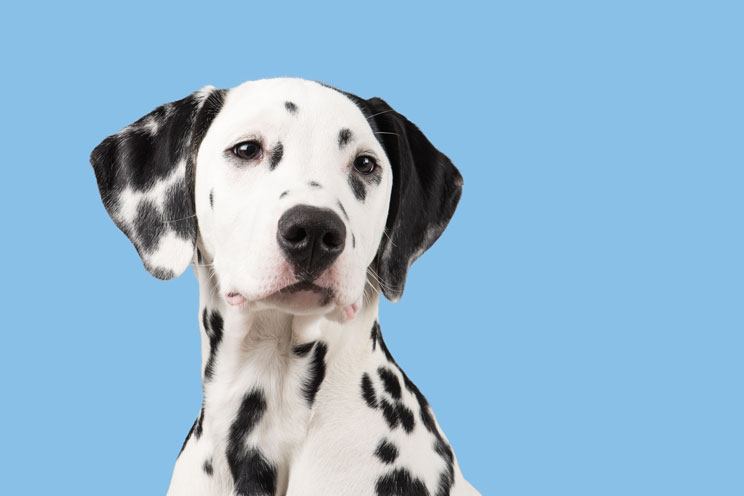
When most of us think of a spotted dog, we think of the Dalmatian. In fact, this is the only dog who truly has spots. Other breeds have patterns known as Merle or ticking. This striking breed is famous for its spotted coat, thanks in part to historically being a fireman’s dog and more recently being featured in movies like 101 Dalmatians.
History of Dalmatian
Dalmatians are the only dog known to have been bred for the purpose of running along with and protecting horses and coaches. No one is sure where the Dalmatian breed first developed, but by the early 1800s it was well-known for being common in an area of Central Europe that was once known as Dalmatia.
Dalmatians ran along with the Romani people, known as gypsies, as they wandered across Europe. Later, they ran along with European coaches and finally began the long association with firefighters when they began running along with horse-drawn fire engines.
Appearance
The Dalmatian is a striking dog, weighing from 45 to 70 pounds. The spots can be either black or liver, and the spots should be well-defined, rather than blotchy. The base coat should always be sparkling white. Dalmatians are lean, graceful dogs who appear effortless in motion.
Personality and lifestyle
Dalmatians were bred to protect their people, horses, and horse-drawn vehicles, and many still have a strong protective instinct and may be wary of strangers. This is a breed that needs to be socialized well in order to accept new people and who will most likely be an excellent watchdog.
Dalmatians are made to run, so you will need to provide your Dalmatian with plenty of exercise if you expect them to be healthy and happy. This is the perfect dog for a long-distance joggers, bikers, or horseback riders. If, for some reason, you are in possession of a horse-drawn carriage, this dog will be perfectly at home by your side.
If you are a fastidious housekeeper, keep in mind that the beautiful sparkling coat of a Dalmatian is kept so clean and shiny because the Dalmatian sheds. A lot. Their coat replaces itself nearly continuously, which is why they always look so beautiful. You can expect to find short stiff hairs all over your floor, upholstery, and clothing. You can be certain that the hair will never blend in since it is always both black and white.
2. Catahoula leopard dog
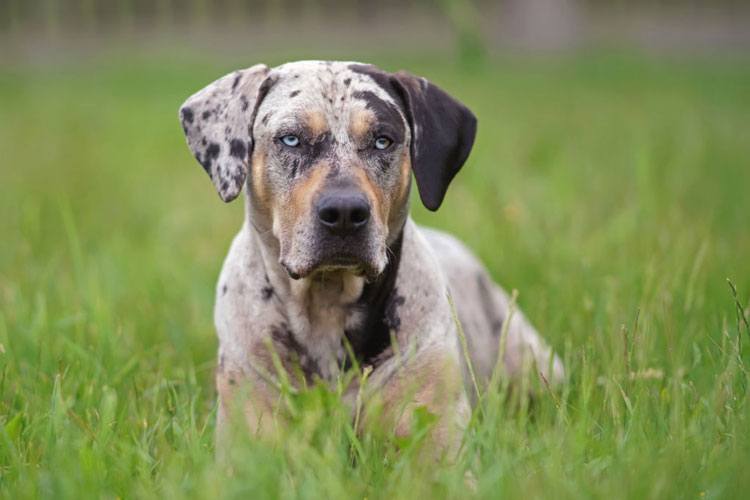
The Catahoula leopard dog is it a true dog of the South, having originated in the state of Louisiana. These striking dogs have lots of personality and can be a handful.
History
When Spanish explorers landed in Florida in the mid-1500s, the only domestic animal that they found was the Native American Dog, which looked like a wolf but barked like a dog. As immigrants moved into the area of United States which is now considered the south, they brought Bloodhounds, Mastiffs, Greyhounds, and other types of hounds which crossbred with the Native American dogs, resulting in the Catahoula Leopard Dog we know today.
The early settlers of Central Louisiana used the dogs to catch wild hogs and cows, which were very common in the area, especially around an area called Catahoula Lake, from which the dogs draws its name. “Catahoula” is a word belonging to the native American tribe the Choctaw. It means, “Sacred lake.”
The dogs developed a unique way of hunting in which they create a “fence” around the herd, keeping individuals from escaping and managing them under the direction of their master. This herding hunting technique is the most essential characteristic of the Catahoula Leopard Dog. While the dog varies in many other traits, this instinct and behavior is what defines the breed.
Appearance
Catahoula Leopard Dogs are big dogs, weighing in at between 50 and 95 lb. They are muscular, powerfully-built dogs with a stocky appearance. The short coat comes in a wide variety of colors and patterns, but speckling across the patterns is common. Spots maybe either well-defined or blotchy and they may be of a range of colors from black to blue to brown. It isn’t unusual to see other markings along with spots in the Catahoula leopard dog, like black and tan markings underneath the spotted coat. The Catahoula has dropped ears with a distinct hound look to them. The eyes may be blue, brown, or any combination of blue and brown.
Personality and lifestyle
The Catahoula is a breed that can think for themselves. Their role throughout history has been both to protect their home and property and fearlessly hunt and herd wild animals. Therefore, this is a dog who tends to be fearless and may be quite independent and protective of its home and people.
This is a dignified breed who does not tolerate mistreatment and will not grovel underneath an overly rough hand. They require consistent, firm, but positive reinforcement and guidance as well as plenty of socialization throughout life in order to develop into well-balanced dogs. With the right handling, the Catahoula Leopard Dog is affectionate and gentle with their family and are excellent watch dogs.
3. Australian Cattle Dog
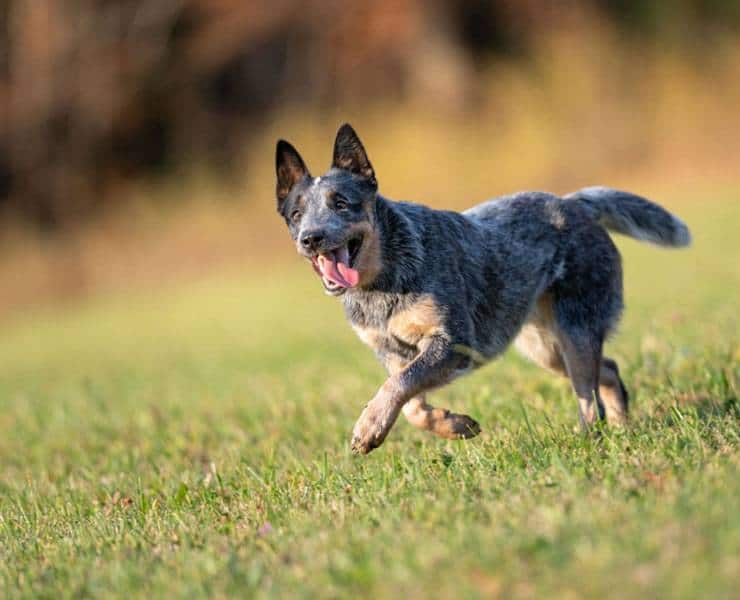
Robust, resilient, and a non-stop powerhouse of energy and activity, the Australian cattle dog is an impressive dog who is related to the Australian wild dog, the dingo.
History
As Australia was settled by British immigrants, cattle farming became a primary source of food and income. In order to handle the cattle over the vast expanses of the Australian grasslands, excellent herding dogs were needed. Herding dogs known as the Smithfield were imported from Britain, but these dogs were ill-suited to the heat, terrain, and long distances of Australia.
These dogs, as well as other herding breeds, were crossbred with wild dingoes in order to create a dog who can handle the work that needed to be done. The result was the Australian Cattle Dog, a powerful working dog with whip-smart intelligence.
Appearance
The Australian cattle dog is a compact dog who is tremendously strong and very well-built. The body is well-muscled throughout, and while this isn’t a huge dog, generally weighing between 35 and 50 lb, they will certainly make you feel like they are the biggest dog in the room. The smooth double coat may vary in color, but nearly all Australian cattle dogs carry the distinctive spotting, or ticking, that gives them such a striking appearance.
Personality and lifestyle
If you don’t have a job for them to do, you probably shouldn’t consider getting an Australian cattle dog. These are true work dogs, and they thrive with strenuous physical activity and difficult mental challenges every day. This is a very healthy, long-lived breed, so you can expect to have a non-stop tornado of a dog in your life for a long time. These dogs tend to be strong-willed and their intelligence means that they can often outsmart their owners, so they need an owner dedicated to training, socialization, and keeping them busy.
4. The bluetick coonhound
The bluetick coonhound is a true dog’s dog, with a strong work drive and a stunning appearance.
History
Like all Coonhounds, the Bluetick Coonhound developed in America. Bluetick bloodlines are said to have begun when French staghounds were given to George Washington as a gift. The dogs were mixed with English Foxhounds and several other hound breeds until they developed excellent endurance and the ability to hunt down scents that are hours or even days old.
These effective hunting dogs were used to hunt raccoons but also were used in packs to hunt big game like wild boar, bear, lynx, and cougars. There is no mistaking the distinctive baying when a Blue Tick Hound gets on the trail, and hunters have been following that sound for many years.
Appearance
The Blue Tick is a big hound dog, weighing in at between 45 and 80 lb and standing quite tall. This is a muscular dog, but they should never seem chunky. They are made to run and run fast. They have typical droopy hound ears which inspire petting. The black and blue ticking pattern is very striking, with some dogs showing more distinct spotting than others. Generally, there are also patches of black or brown on the coat and there may also be black and tan markings. The short coats lays close to the body and is rather coarse but not rough.
Personality and lifestyle
Bluetick Coonhounds crave the affection of everyone in their family and are generally very affectionate. This is a dog who may not excel as a watchdog, except for their capacity to announce the presence of a stranger with their loud baying. The bluetick coonhound has a powerful prey drive that cannot be trained away, so they must be leashed anytime they are not somewhere that is safe for them to run free.
Blueticks cannot be trusted loose in a yard, as they will quickly use their athleticism to help them follow a scent wherever it goes, including over or under a fence. Provided you can give this dog sufficient exercise, they make charming family pets.
5. English Setter
If you are looking for a true supermodel of the spotted dog world, look no further than the sweet, friendly English Setter.
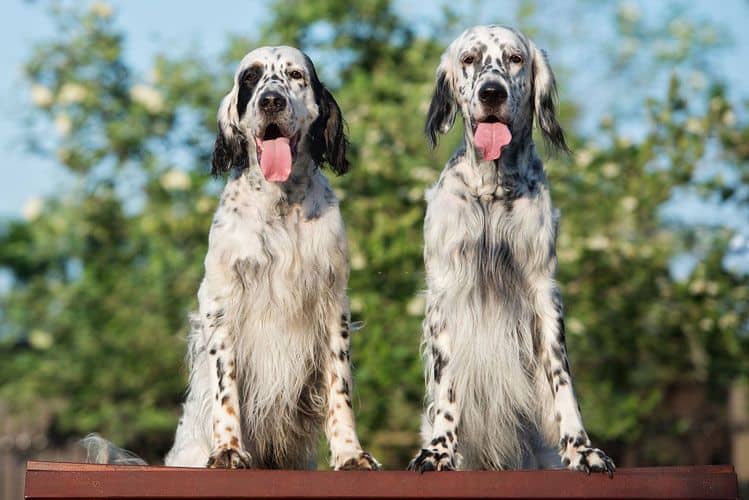
History
The English Setter has been a breed for around 400 or 500 years. They were bred to lay down quietly, which is called setting, whenever they located game birds. This allowed the hunter to cast a net over the area, often covering the dog as well, at which point they would flush the birds and ensnare them within the net. The low-lying tendency was useful in order to avoid having a dog get tangled in the net.
As time went on and guns replaced nets, the setter was bred to stand instead of lie down, since there was no longer a worry about them being trapped in the net and so that the hunter could see them more easily. The striking spotted coat may also have been developed in an attempt to make the dogs easier to see.
Appearance
The English Setter is a true supermodel of the dog world. Weighing in between 65 and 80 lb, this tall dog is covered in a gorgeous speckled coat pattern of a range of colors. The base coat is usually white, with speckles of colors like liver, lemon, black, brown, and orange. The speckles appear more defined where the coat is short on the head and legs and are more obscure where the coat is feathered on the chest, body, ears, and tail.
These dogs have a long, graceful neck and droopy ears which give them an adorably mournful appearance. The silky coat is wonderfully soft and inspires petting.
Personality and lifestyle
The English Setter is a merry, happy go lucky breed that loves people, other dogs, and pretty much everything. They need a fair amount of exercise, but unlike hound-dogs which may follow the scent away, English Setters can be trained to play safely in a large yard. English Setters also do very well going on a jog, bicycle ride, or even on a long walk or hike.
These are highly sensitive dogs who do not take well to any kind of punishment or harsh treatment, so they should be carefully trained with only positive reinforcement and kept from negative experiences so as not to bruise their sensitive natures. The long silky coat requires regular grooming and sheds a fair amount, so if you don’t want to do a lot of upkeep on your dog’s coat, the English Setter might not be the right pick for you.
6. Australian Shepherd
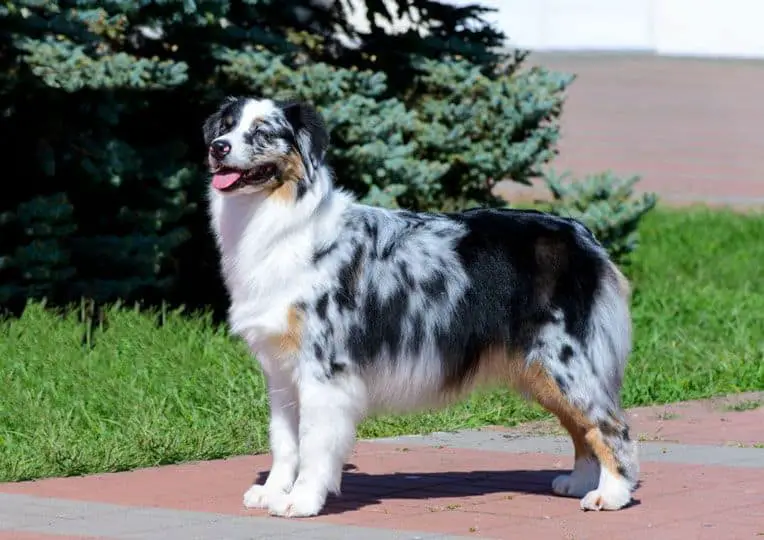
The Australian Shepherd is a stunningly beautiful dog who excels in all forms of agility, obedience, and other training.
History
The Australian Shepherd began its history in Europe, as a herding dog between France and Spain. As immigrants began moving to and colonizing Australia, they brought their herding dogs with them in order to help them manage the wide-open pastures of sheep.
In order to better manage the environment of Australia, the dogs were bred to Collies and Border Collies, along with other breeds. Americans visiting Australia at the time were impressed by the dog and brought them back, where they began a long history accompanying American Cowboys.
Appearance
The Australian Shepherd is a medium-sized dog, weighing from 40 to 65 lb. They have a strikingly penetrating gaze and may have either brown or blue eyes. The coat can be a range of colors and patterns, but the most recognizable is the Merle pattern with mottled spots and blotches in a range of colors. They have a soft, flowing medium-length coat with feathering on the legs, tail, and around the face. Cute triangle-shaped folded ears contribute to an alert expression.
Personality and lifestyle
The Australian Shepherd is an extremely smart dog who is driven to actively serve their owners. They have an extremely strong herding instinct which can sometimes cause them to herd cats, birds, and even other dogs and children. If you would rather your Aussie not herd everybody in your family, you need to provide them with plenty of structured activities in order to occupy their eager minds and energetic bodies.
Unlike some other intelligent breeds, the Australian Shepherd is more likely to use their smarts trying to please you than trying to outsmart you. This is a devoted dog who needs to be in the center of their family’s life. The gorgeous, waterproof, double coat sheds a fair amount year-round and replaces itself seasonally, so get ready for some regular grooming if you choose this breed.
7. Dachshund
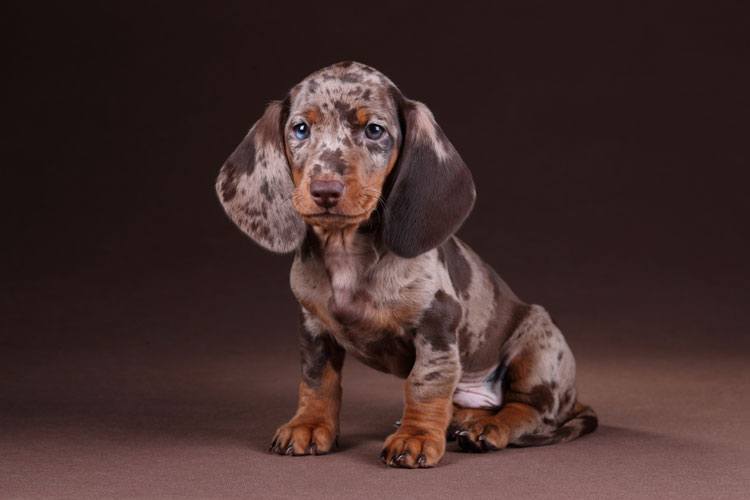
The short-legged Dachshund is as charming as they are adorable. These tiny hounds have a vivacious personality which makes them a favorite for many.
History
The Dachshund was bred in Germany to hunt Badgers around six hundred years ago. The low body was designed to go into the Badger’s hole and this dog was bred with a courageous personality that gave it the bravery to take on one of the most vicious predators known to man.
If you’ve ever been surprised by how loud the Dachshund can bark, you’re hearing the history of this breed in the bark. They were bred to have an exceptionally loud bark so that the hunter could locate and mark his Dachshund’s underground location. Different sizes and coat types were developed in order to hunt different quarries. Packs of Dachshunds were even used to hunt wild boar, which is hard to imagine today.
Appearance
The Dachshund comes in two sizes, the 16 to 32 lb standard and the 11 lb or under miniature. These dogs are so short because they have a gene for dwarfism which causes their legs to stop growing at about half the length of a normal dog’s legs. Dachshunds come in three coat types: smooth, long, and wiry.
They come in a wide range of colors and patterns. The beautiful spotted pattern that some dachshunds have is known as dapple. Some dachshunds have extensive dappling, causing them to look like they have spots of different colors all over their bodies, while other dachshunds have no dappling. Dappling is a pattern that can occur on any color, so there is an incredibly wide range of spotted appearances for the Dachshund.
Personality and lifestyle
The Dachshund is well-loved for their friendly and spunky personalities. These little dogs are friendly, vivacious, and fearless. These little dogs can be stubborn, and they know how to use those adorable eyes and droopy ears to manipulate their owners. If you don’t mind a little dog who makes you laugh until you cry while walking all over you, you’ll probably appreciate the Dachshund.
If you like a snuggling buddy, you will appreciate the Dachshund’s tendency to snuggle underneath the blankets with you. On the other hand, if you are an avid gardener, you may not appreciate the Dachshund’s love of digging. This breed also retains a strong prey drive which means they can usually not be trusted off-leash.
8. Cardigan Welsh Corgi
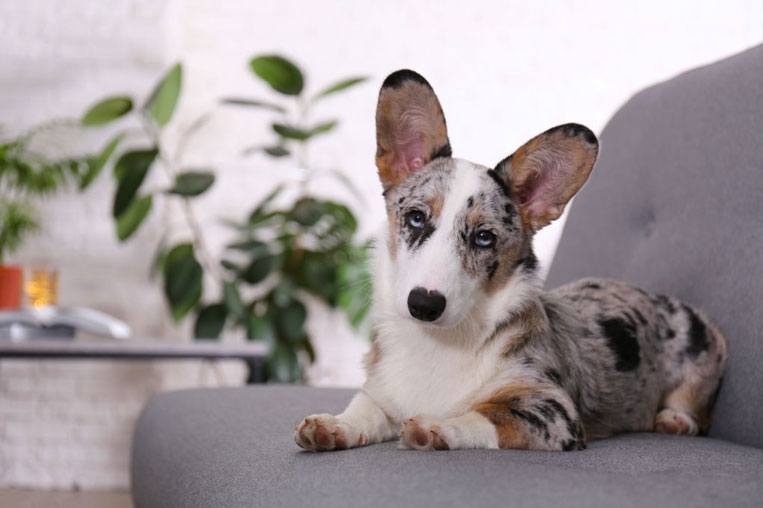
There are two types of Corgi, the Cardigan and the Pembroke, but only the less common Cardigan Corgi carries the beautiful spotted coloration.
History
Both Cardigan and Pembroke Welsh Corgis developed in Wales as many as 1,000 years ago. Although these breeds may look similar to us, they developed separately in separate parts of Wales and are considered completely different breeds.
The word Corgi is an ancient Celtic word for dog, and it may be that Corgis were brought to Central Europe by the Celts around 1200 BC. Cardigan Corgis have a dwarfism gene that results in legs that are about half the length of a normal dog’s legs. This trait was beneficial to herders because it allowed corgis to herd cattle while staying underneath the heels of kicking cows.
Appearance
The Cardigan Welsh Corgi is a painfully adorable dog, with its giant upright ears and low-slung body. Unlike the Pembroke, the Cardigan has a long, fluffy tail which helped it to navigate the mountainous areas in which it was developed. Merle Cardigan Welsh Corgis are usually blue with black spots and blotches, typically with a white marking like a bandana around the neck. The eyes may be brown or blue or any combination of the two. These dogs are short but not as small as you might think, weighing between 25 and 35 lbs on average.
Personality and lifestyle
Cardigan Welsh Corgis are very trainable dogs who are loyal to their families and generally get along well with kids and other pets. Like all herding breeds, they can’t have a tendency to herd other dogs, kids, birds, etc, but in general, the Welsh Corgi’s herding instinct may not be quite as strong as some other herding breeds and can be redirected with proper training and socialization. Keep in mind that the beautiful spotted coat does its fair share of shedding, especially seasonally when the coat is replaced.
9. American hairless Terrier
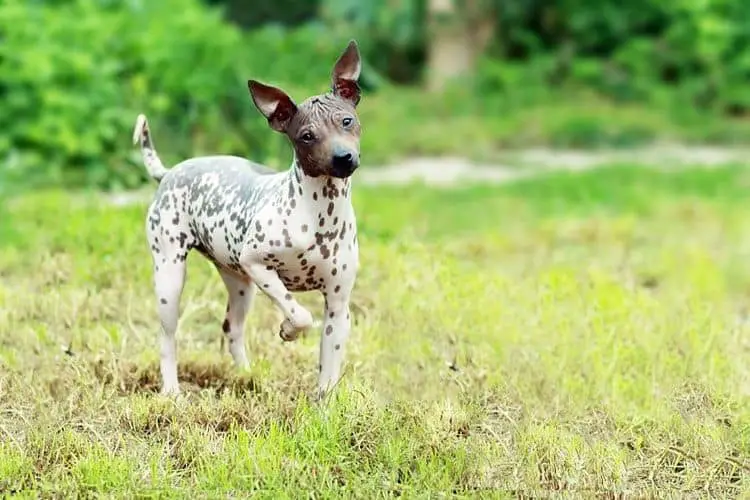
The American Hairless Terrier may look exotic, but it is, in fact, a Louisiana native. These dogs come in both haired and hairless varieties, and most dogs carry characteristic spots.
History
The American Hairless Terrier is a natural genetic variant of the Rat Terrier. Rat Terriers were developed in the early 1800s for a purpose that is clear by their name. These ferocious little dogs were said to be able to kill thousands of rats on a single day. Putting the dogs into a pit of rats was even considered a spectator sport.
In the late 1800s, British immigrants moving to America brought their Rat Terriers with them. It wasn’t until the 1970s that a hairless pup was born to a regular litter of rat terriers. This wasn’t known immediately since hairless rat terriers are born with a birth coat that falls out once they are several weeks old. When this puppy was bred, she produced another hairless dog in her litter. As time went on, hairless puppies became more predictable until this became a separate breed, but it did not gain full AKC recognition until 2016.
Appearance
The most notable feature of the American Hairless Terrier is, of course, that they are without fur. Some individuals are entirely hairless while others have some hair around the face, especially the eyebrows and whiskers. The skin is smooth and surprisingly warm to the touch. These dogs have a wedge-shaped head and erect V-shaped ears which make them look extremely intelligent. They also have distinct wrinkling on their forehead, especially when they are alert, which makes them look like they are concentrating very hard on something.
While not all individuals have spots, the vast majority have spots that are thicker on the back so as to be almost a solid color and become more dispersed as they move down the legs, making it look almost as though they have had their spots poured over them. These are little dogs, weighing between 12 and 16 lb. They have a jaunty, smooth way of moving and look very graceful in motion.
Personality and lifestyle
The American Hairless Terrier is a smart, curious little dog who loves to play and bonds closely with their family. They can be very protective of their humans and make excellent watchdogs, but they generally get along well with everyone when properly socialized.
Because they are hairless, they are some of the most hypoallergenic dogs that you can find. People are not allergic to hair, but rather the dander that sticks to it. While American hairless terriers have dander like any dog, simply wiping their smooth skin off with a damp cloth will easily remove it, eliminating allergic reactions.
It is important to keep in mind, however, that if you live in a very cold climate, these dogs will need many layers to stay warm and should not be outside long. If you live in a sunny climate, you will need to provide sunscreen for your dog.
10. German Shorthaired Pointer
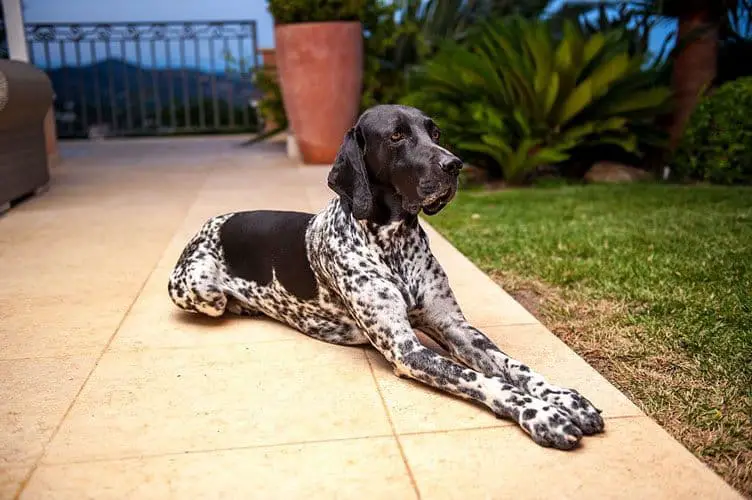
The German Shorthaired Pointer is perhaps one of the most dedicated runners in the dog world. They are stunning in stillness as well as in motion.
History
The German Shorthaired Pointer was developed in the 1800’s as a versatile bird dog. Germans had been breeding bird dogs for at least a hundred years prior to creating this dog, and it is believed that it took many generations and breeds in order to arrive at this ideal hunting dog.
There is no question that they were successful, however, as the German Shorthaired Pointer still is a top winning breed in competitive hunting events today. These dogs have webbed feet in order to make them excellent swimmers who can track their game on land or water. They’re versatile dogs who are as comfortable hunting possum, raccoon, rabbit, and even deer as they are hunting birds.
Appearance
The German Shorthaired Pointer is a large, striking dog weighing between 50 and 70 lb. The coat is either solid liver or white with liver ticking. The head and ears are always solid liver. These dogs tend to have variably sized ticking but tending towards the small side, creating an effect of spots of many different sizes across the body.
This dog is built to run. Their ppearance is noble and elegant. The drop ears and kind eyes give them a gentle expression which causes them to be appealing despite their size and strength.
Personality and lifestyle
This is a true athlete of the dog world. A German Shorthaired Pointer will happily run all day long and may not even seem tired at the end of it. If you have an extremely active family, this dog may be a good fit for you. Happy, friendly, and outgoing, the German Shorthaired Pointer is a friend to all.
They generally do great in families and will likely get along well with other dogs, provided the other dogs can keep up with their endless energy. These are extremely trainable dogs who are happy to learn to do just about anything for you. If you want a dog will be with you through all of your many activities and you don’t mind working through this dog’s tendency towards prey drive and endless energy, the German Shorthaired Pointer might be the right pick for you.

